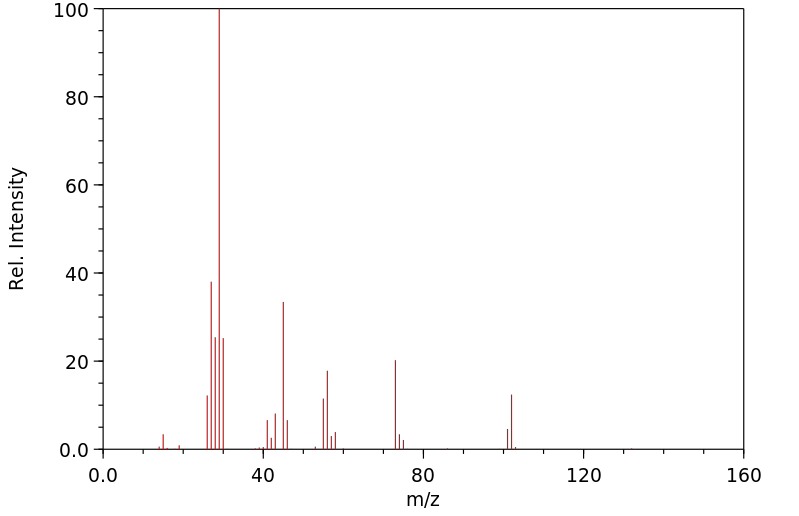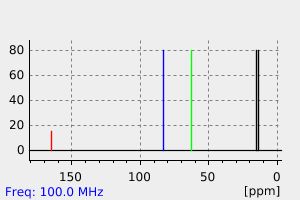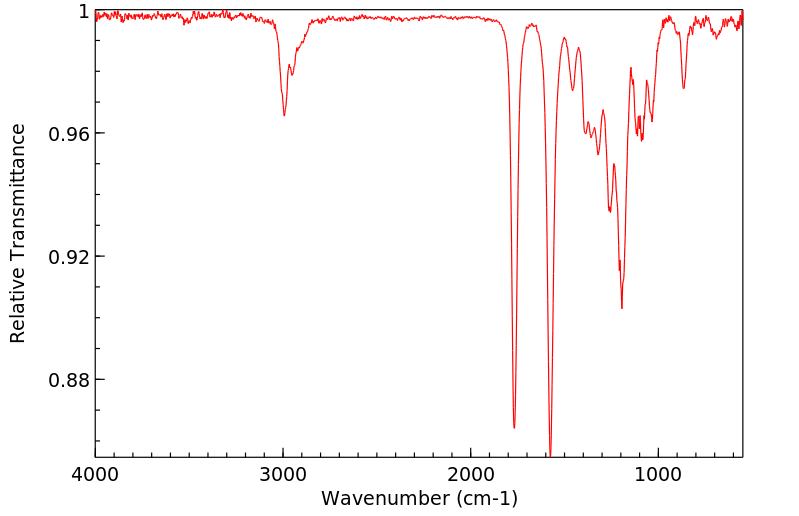2-硝基丙酸乙酯 | 2531-80-8
中文名称
2-硝基丙酸乙酯
中文别名
——
英文名称
ethyl 2-nitropropionate
英文别名
ethyl 2-nitropropanoate
CAS
2531-80-8
化学式
C5H9NO4
mdl
MFCD00024818
分子量
147.131
InChiKey
ZXBGJDZWJJFFQY-UHFFFAOYSA-N
BEILSTEIN
——
EINECS
——
-
物化性质
-
计算性质
-
ADMET
-
安全信息
-
SDS
-
制备方法与用途
-
上下游信息
-
文献信息
-
表征谱图
-
同类化合物
-
相关功能分类
-
相关结构分类
物化性质
-
沸点:75-76 °C/9 mmHg (lit.)
-
密度:1.13 g/mL at 25 °C (lit.)
-
闪点:193 °F
-
稳定性/保质期:
在常温常压下保持稳定,应避免与氧化剂接触。
计算性质
-
辛醇/水分配系数(LogP):0.9
-
重原子数:10
-
可旋转键数:3
-
环数:0.0
-
sp3杂化的碳原子比例:0.8
-
拓扑面积:72.1
-
氢给体数:0
-
氢受体数:4
安全信息
-
TSCA:Yes
-
危险等级:IRRITANT
-
危险品标志:Xi
-
安全说明:S26,S36
-
危险类别码:R36/37/38
-
海关编码:2915900090
-
WGK Germany:3
-
储存条件:请将容器密封,并将其存放在一个紧密封装的容器中。建议储存在阴凉、干燥的地方。
SDS
Section 1. IDENTIFICATION OF THE SUBSTANCE/MIXTURE
Product identifiers
Product name : Ethyl 2-nitropropionate
CAS-No. : 2531-80-8
Relevant identified uses of the substance or mixture and uses advised against
Identified uses : Laboratory chemicals, Manufacture of substances
Section 2. HAZARDS IDENTIFICATION
Classification of the substance or mixture
Classification according to Regulation (EC) No 1272/2008 [EU-GHS/CLP]
Skin irritation (Category 2)
Eye irritation (Category 2)
Specific target organ toxicity - single exposure (Category 3)
Classification according to EU Directives 67/548/EEC or 1999/45/EC
Irritating to eyes, respiratory system and skin.
Label elements
Labelling according Regulation (EC) No 1272/2008 [CLP]
Pictogram
Signal word Warning
Hazard statement(s)
H315 Causes skin irritation.
H319 Causes serious eye irritation.
H335 May cause respiratory irritation.
Precautionary statement(s)
P261 Avoid breathing dust/ fume/ gas/ mist/ vapours/ spray.
P305 + P351 + P338 IF IN EYES: Rinse cautiously with water for several minutes. Remove
contact lenses, if present and easy to do. Continue rinsing.
Supplemental Hazard none
Statements
According to European Directive 67/548/EEC as amended.
Hazard symbol(s)
R-phrase(s)
R36/37/38 Irritating to eyes, respiratory system and skin.
S-phrase(s)
S26 In case of contact with eyes, rinse immediately with plenty of water and
seek medical advice.
S36/37/39 Wear suitable protective clothing, gloves and eye/face protection.
Other hazards - none
Section 3. COMPOSITION/INFORMATION ON INGREDIENTS
Substances
Formula : C5H9NO4
Molecular Weight : 147,13 g/mol
Component Concentration
Propanoic acid, 2-nitro-, ethyl ester
CAS-No. 2531-80-8 -
Section 4. FIRST AID MEASURES
Description of first aid measures
General advice
Consult a physician. Show this safety data sheet to the doctor in attendance.
If inhaled
If breathed in, move person into fresh air. If not breathing, give artificial respiration. Consult a physician.
In case of skin contact
Wash off with soap and plenty of water. Consult a physician.
In case of eye contact
Rinse thoroughly with plenty of water for at least 15 minutes and consult a physician.
If swallowed
Do NOT induce vomiting. Never give anything by mouth to an unconscious person. Rinse mouth with
water. Consult a physician.
Most important symptoms and effects, both acute and delayed
To the best of our knowledge, the chemical, physical, and toxicological properties have not been
thoroughly investigated.
Indication of any immediate medical attention and special treatment needed
no data available
Section 5. FIREFIGHTING MEASURES
Extinguishing media
Suitable extinguishing media
For small (incipient) fires, use media such as "alcohol" foam, dry chemical, or carbon dioxide. For large
fires, apply water from as far as possible. Use very large quantities (flooding) of water applied as a mist or
spray; solid streams of water may be ineffective. Cool all affected containers with flooding quantities of
water.
Special hazards arising from the substance or mixture
Carbon oxides, nitrogen oxides (NOx)
Advice for firefighters
Wear self contained breathing apparatus for fire fighting if necessary.
Further information
Use water spray to cool unopened containers.
Section 6. ACCIDENTAL RELEASE MEASURES
Personal precautions, protective equipment and emergency procedures
Use personal protective equipment. Avoid breathing vapors, mist or gas. Ensure adequate ventilation.
Remove all sources of ignition. Evacuate personnel to safe areas. Beware of vapours accumulating to
form explosive concentrations. Vapours can accumulate in low areas.
Environmental precautions
Prevent further leakage or spillage if safe to do so. Do not let product enter drains.
Methods and materials for containment and cleaning up
Contain spillage, and then collect with an electrically protected vacuum cleaner or by wet-brushing and
place in container for disposal according to local regulations (see section 13). Keep in suitable, closed
containers for disposal.
Reference to other sections
For disposal see section 13.
Section 7. HANDLING AND STORAGE
Precautions for safe handling
Avoid contact with skin and eyes. Avoid inhalation of vapour or mist.
Keep away from sources of ignition - No smoking.Take measures to prevent the build up of electrostatic
charge.
Conditions for safe storage, including any incompatibilities
Store in cool place. Keep container tightly closed in a dry and well-ventilated place. Containers which are
opened must be carefully resealed and kept upright to prevent leakage.
Specific end use(s)
no data available
Section 8. EXPOSURE CONTROLS/PERSONAL PROTECTION
Control parameters
Components with workplace control parameters
Exposure controls
Appropriate engineering controls
Handle in accordance with good industrial hygiene and safety practice. Wash hands before breaks and
at the end of workday.
Personal protective equipment
Eye/face protection
Safety glasses with side-shields conforming to EN166 Use equipment for eye protection tested
and approved under appropriate government standards such as NIOSH (US) or EN 166(EU).
Skin protection
Handle with gloves. Gloves must be inspected prior to use. Use proper glove removal technique
(without touching glove's outer surface) to avoid skin contact with this product. Dispose of
contaminated gloves after use in accordance with applicable laws and good laboratory practices.
Wash and dry hands.
The selected protective gloves have to satisfy the specifications of EU Directive 89/686/EEC and
the standard EN 374 derived from it.
Body Protection
impervious clothing, The type of protective equipment must be selected according to the
concentration and amount of the dangerous substance at the specific workplace.
Respiratory protection
Where risk assessment shows air-purifying respirators are appropriate use a full-face respirator
with multi-purpose combination (US) or type ABEK (EN 14387) respirator cartridges as a backup
to engineering controls. If the respirator is the sole means of protection, use a full-face supplied air
respirator. Use respirators and components tested and approved under appropriate government
standards such as NIOSH (US) or CEN (EU).
Section 9. PHYSICAL AND CHEMICAL PROPERTIES
Information on basic physical and chemical properties
a) Appearance Form: liquid
Colour: light yellow
b) Odour no data available
c) Odour Threshold no data available
d) pH no data available
e) Melting point/freezing no data available
point
f) Initial boiling point and 75 - 76 °C at 12 hPa - lit.
boiling range
g) Flash point 89 °C - closed cup
h) Evaporation rate no data available
i) Flammability (solid, gas) no data available
j) Upper/lower no data available
flammability or
explosive limits
k) Vapour pressure no data available
l) Vapour density no data available
m) Relative density 1,13 g/cm3 at 25 °C
n) Water solubility no data available
o) Partition coefficient: n- no data available
octanol/water
p) Auto-ignition no data available
temperature
q) Decomposition no data available
temperature
r) Viscosity no data available
s) Explosive properties no data available
t) Oxidizing properties no data available
Other safety information
no data available
Section 10. STABILITY AND REACTIVITY
Reactivity
no data available
Chemical stability
no data available
Possibility of hazardous reactions
no data available
Conditions to avoid
Heat, flames and sparks.
Incompatible materials
Strong oxidizing agents, Strong bases
Hazardous decomposition products
Other decomposition products - no data available
Section 11. TOXICOLOGICAL INFORMATION
Information on toxicological effects
Acute toxicity
no data available
Skin corrosion/irritation
no data available
Serious eye damage/eye irritation
no data available
Respiratory or skin sensitization
no data available
Germ cell mutagenicity
no data available
Carcinogenicity
IARC: No component of this product present at levels greater than or equal to 0.1% is identified as
probable, possible or confirmed human carcinogen by IARC.
Reproductive toxicity
no data available
Specific target organ toxicity - single exposure
Inhalation - May cause respiratory irritation.
Specific target organ toxicity - repeated exposure
no data available
Aspiration hazard
no data available
Potential health effects
Inhalation May be harmful if inhaled. Causes respiratory tract irritation.
Ingestion May be harmful if swallowed.
Skin May be harmful if absorbed through skin. Causes skin irritation.
Eyes Causes serious eye irritation.
Signs and Symptoms of Exposure
To the best of our knowledge, the chemical, physical, and toxicological properties have not been
thoroughly investigated.
Additional Information
RTECS: Not available
Section 12. ECOLOGICAL INFORMATION
Toxicity
no data available
Persistence and degradability
no data available
Bioaccumulative potential
no data available
Mobility in soil
no data available
Results of PBT and vPvB assessment
no data available
Other adverse effects
no data available
Section 13. DISPOSAL CONSIDERATIONS
Waste treatment methods
Product
This combustible material may be burned in a chemical incinerator equipped with an afterburner and
scrubber. Offer surplus and non-recyclable solutions to a licensed disposal company. Contact a licensed
professional waste disposal service to dispose of this material.
Contaminated packaging
Dispose of as unused product.
Section 14. TRANSPORT INFORMATION
UN number
ADR/RID: - IMDG: - IATA: -
UN proper shipping name
ADR/RID: Not dangerous goods
IMDG: Not dangerous goods
IATA: Not dangerous goods
Transport hazard class(es)
ADR/RID: - IMDG: - IATA: -
Packaging group
ADR/RID: - IMDG: - IATA: -
Environmental hazards
ADR/RID: no IMDG Marine Pollutant: no IATA: no
Special precautions for user
no data available
SECTION 15 - REGULATORY INFORMATION
N/A
SECTION 16 - ADDITIONAL INFORMATION
N/A
上下游信息
-
上游原料
中文名称 英文名称 CAS号 化学式 分子量 —— 2-nitroso-propionic acid ethyl ester 859954-00-0 C5H9NO3 131.131 硝基乙酸乙酯 nitroacetic acid ethyl ester 626-35-7 C4H7NO4 133.104 —— ethyl 3-hydroxy-2-methyl-2-nitropropanoate 88226-52-2 C6H11NO5 177.157 -
下游产品
中文名称 英文名称 CAS号 化学式 分子量 2-甲基-2-硝基丙酸乙酯 ethyl 2-methyl-2-nitropropionate 5342-77-8 C6H11NO4 161.158 —— ethyl 3-hydroxy-2-methyl-2-nitropropanoate 88226-52-2 C6H11NO5 177.157
反应信息
-
作为反应物:参考文献:名称:从硝基到羰基的新转化摘要:通过用碱和MoO 5 ·Pyr·HMPA处理将硝基化合物转化为相应的羰基化合物。DOI:10.1016/s0040-4039(01)92468-2
-
作为产物:参考文献:名称:借助HOF·CH 3 CN配合物将天然氨基酸转化为α-烷基取代的氨基酸摘要:α-烷基氨基酸可以由各自的氨基酸本身以高收率高效地制备。关键步骤是胺官能团的氧化,以快速且非常高的收率反应生成相应的α-硝基酸,然后进行相转移烷基化,最后还原为所需的α-烷基氨基酸。合适的底物是几种含有芳香环或其他羧基的酸和在α-位具有位阻的酸。研究了几种烷基卤作为烷基化剂。DOI:10.1021/jo0709450
文献信息
-
Recent Advances in Electrophilic CF3-Transfer Using Hypervalent Iodine(III) Reagents作者:Iris Kieltsch、Patrick Eisenberger、Kyrill Stanek、Antonio TogniDOI:10.2533/chimia.2008.260日期:——
The development of new methodologies for an efficient introduction of CF3 groups into complex molecules constitutes one of the most challenging tasks of modern organic chemistry. Recently, we reported the access to a new class of electrophilic CF3-transfer reagents based on hypervalent iodine. The versatile application of these reagents to C-centred nucleophiles, such as ?-keto esters, silyl enol ethers and ?-nitro esters, as well as to thiols and primary and secondary phosphines is described. Experiments with phenols afforded corresponding trifluomethylethers in very low yields.
-
4-Amino-1,5-dihydro-2<i>H</i>-pyrrol-2-one aus Bortrifluorid-katalysierten Umsetzungen von 3-Amino-2<i>H</i>-azirinen mit Carbonsäure-Derivaten
-
Synthesis of 2-substituted-3-nitroimidazo[1,2-<i>b</i>]pyridazines as potential biologically active agents作者:Thierry Terme、Joséa Maldonado、Michel P. Crozet、Patrice Vanelle、Christophe Galtier、Alain GueiffierDOI:10.1002/jhet.5570390125日期:2002.1first time. It was shown to react under phase-transfer catalysis conditions with 2-nitropropane anion by an SRN1 mechanism to give excellent yield of isopropylidene derivative formed from a base-promoted nitrous acid elimination of C-alkylation product. Extension of this SRN1 reaction to various nitronate anions led to a new class of 3-nitroimidazo[1,2-b]pyridazine derivatives bearing a trisub-stituted
-
Transition‐Metal‐Free Three‐Component Synthesis of Tertiary Aryl Amines from Nitro Compounds, Boronic Acids, and Trialkyl Phosphites作者:Silvia Roscales、Aurelio G. CsákyDOI:10.1002/adsc.201901009日期:2020.1.7aromatic amines is of continuous interest in chemistry. An exceptionally versatile three‐component reaction that directly transforms inexpensive nitro compounds, boronic acids, and trialkyl phosphites into tertiary aromatic amines has been realized. The reaction tolerates alkyl and aryl substituents on the nitro and boronic acid moieties, as well as functionalized phosphites. No transition‐metal catalysis
-
Activation of diverse carbon–heteroatom and carbon–carbon bonds via palladium(ii)-catalysed β-X elimination作者:Van T. Tran、John A. Gurak、Kin S. Yang、Keary M. EngleDOI:10.1038/s41557-018-0110-z日期:2018.11nickel(0), rhodium(i), ruthenium(0) and iron catalysts under conditions finely tuned for specific, electronically activated substrates, sometimes assisted by chelating functional groups or ring strain. By adopting a redox-neutral strategy involving palladium(ii)-catalysed C–H activation followed by β-heteroatom/carbon elimination, we describe here a catalytic method to activate alkyl C(sp3)–oxygen, nitrogen化学家从简单的起始原料合成结构复杂的高价值有机分子的能力受到选择性激活和功能化强烷基C(sp 3)共价键的方法的限制。最近的活动集中在通过低价,富电子的过渡金属的氧化加成的机理范式来激活丰富的C-O,C-N和C-C键。该方法通常在针对特定的电子活化底物进行微调的条件下使用镍(0),铑(i),钌(0)和铁催化剂,有时可通过螯合官能团或环应变来辅助。通过采用涉及钯的氧化还原中性策略(二)催化的C–H活化,然后去除β-杂原子/碳,我们在此描述了一种催化方法,该方法以高区域选择性活化烷基C(sp 3)–氧,氮,碳,氟和硫键。生成的钯(ii)结合的烯烃的直接加氢官能化导致形式化的官能团复分解。该方法用于氨基酸的提纯,具有完全的区域选择性和对映体过量的中等至高保留率。低应变杂环经过强键活化和取代,产生开环产物。
表征谱图
-
氢谱1HNMR
-
质谱MS
-
碳谱13CNMR
-
红外IR
-
拉曼Raman
-
峰位数据
-
峰位匹配
-
表征信息
同类化合物
(甲基3-(二甲基氨基)-2-苯基-2H-azirene-2-羧酸乙酯)
(±)-盐酸氯吡格雷
(±)-丙酰肉碱氯化物
(d(CH2)51,Tyr(Me)2,Arg8)-血管加压素
(S)-(+)-α-氨基-4-羧基-2-甲基苯乙酸
(S)-阿拉考特盐酸盐
(S)-赖诺普利-d5钠
(S)-2-氨基-5-氧代己酸,氢溴酸盐
(S)-2-[[[(1R,2R)-2-[[[3,5-双(叔丁基)-2-羟基苯基]亚甲基]氨基]环己基]硫脲基]-N-苄基-N,3,3-三甲基丁酰胺
(S)-2-[3-[(1R,2R)-2-(二丙基氨基)环己基]硫脲基]-N-异丙基-3,3-二甲基丁酰胺
(S)-1-(4-氨基氧基乙酰胺基苄基)乙二胺四乙酸
(S)-1-[N-[3-苯基-1-[(苯基甲氧基)羰基]丙基]-L-丙氨酰基]-L-脯氨酸
(R)-乙基N-甲酰基-N-(1-苯乙基)甘氨酸
(R)-丙酰肉碱-d3氯化物
(R)-4-N-Cbz-哌嗪-2-甲酸甲酯
(R)-3-氨基-2-苄基丙酸盐酸盐
(R)-1-(3-溴-2-甲基-1-氧丙基)-L-脯氨酸
(N-[(苄氧基)羰基]丙氨酰-N〜5〜-(diaminomethylidene)鸟氨酸)
(6-氯-2-吲哚基甲基)乙酰氨基丙二酸二乙酯
(4R)-N-亚硝基噻唑烷-4-羧酸
(3R)-1-噻-4-氮杂螺[4.4]壬烷-3-羧酸
(3-硝基-1H-1,2,4-三唑-1-基)乙酸乙酯
(2S,4R)-Boc-4-环己基-吡咯烷-2-羧酸
(2S,3S,5S)-2-氨基-3-羟基-1,6-二苯己烷-5-N-氨基甲酰基-L-缬氨酸
(2S,3S)-3-((S)-1-((1-(4-氟苯基)-1H-1,2,3-三唑-4-基)-甲基氨基)-1-氧-3-(噻唑-4-基)丙-2-基氨基甲酰基)-环氧乙烷-2-羧酸
(2S)-2,6-二氨基-N-[4-(5-氟-1,3-苯并噻唑-2-基)-2-甲基苯基]己酰胺二盐酸盐
(2S)-2-氨基-N,3,3-三甲基-N-(苯甲基)丁酰胺
(2S)-2-氨基-3-甲基-N-2-吡啶基丁酰胺
(2S)-2-氨基-3,3-二甲基-N-(苯基甲基)丁酰胺,
(2S)-2-氨基-3,3-二甲基-N-2-吡啶基丁酰胺
(2S,4R)-1-((S)-2-氨基-3,3-二甲基丁酰基)-4-羟基-N-(4-(4-甲基噻唑-5-基)苄基)吡咯烷-2-甲酰胺盐酸盐
(2R,3'S)苯那普利叔丁基酯d5
(2R)-2-氨基-3,3-二甲基-N-(苯甲基)丁酰胺
(2-氯丙烯基)草酰氯
(1S,3S,5S)-2-Boc-2-氮杂双环[3.1.0]己烷-3-羧酸
(1R,5R,6R)-5-(1-乙基丙氧基)-7-氧杂双环[4.1.0]庚-3-烯-3-羧酸乙基酯
(1R,4R,5S,6R)-4-氨基-2-氧杂双环[3.1.0]己烷-4,6-二羧酸
齐特巴坦
齐德巴坦钠盐
齐墩果-12-烯-28-酸,2,3-二羟基-,苯基甲基酯,(2a,3a)-
齐墩果-12-烯-28-酸,2,3-二羟基-,羧基甲基酯,(2a,3b)-(9CI)
黄酮-8-乙酸二甲氨基乙基酯
黄荧菌素
黄体生成激素释放激素(1-6)
黄体生成激素释放激素 (1-5) 酰肼
黄体瑞林
麦醇溶蛋白
麦角硫因
麦芽聚糖六乙酸酯
麦根酸









